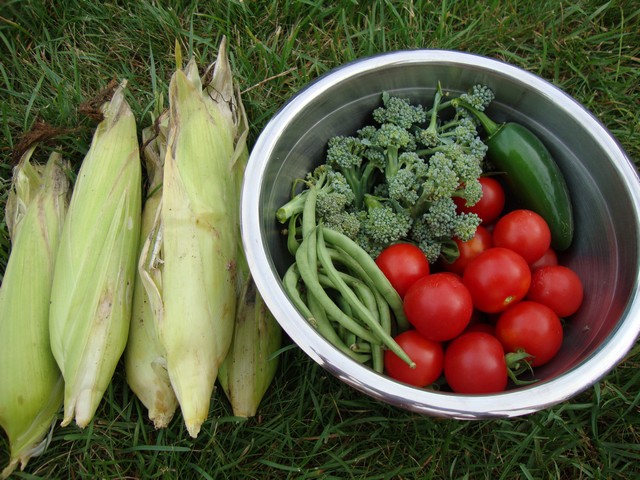
2010 was a year of much learning for me as I took on my first year of in-ground gardening with vegetables. Up until then I had for the most part only grown tomatoes in pots, so I had a lot to learn in order to get a new vegetable garden going. We also needed a proper fence to keep animals out, which my husband built for me; here’s the post with a picture tutorial on the fence he put up. I decided I wanted to try a fairly large variety of plants in order to learn what I would enjoy working with, and what would end up with a good yield for me. While planning, there were several big questions: What to do in order to put in a garden in the first place, which vegetables to choose, and how to plant and grow them. It seemed like a daunting project!! But after studying one plant at a time, I found that it was quite doable after all!
I will do a quick break-down in this post on each plant and why I did or didn’t enjoy growing them. Later I will go through and describe in more detail things I have learned along the way on some of these plants, and some handy tips to be aware of. Some helpful links will be found in this post.
Tomatoes was a given, so I planted a ton of plants from seed, kept some of the stronger ones, pulled the weak ones, and gave the rest away to friends and family. Giving away plants, some of which ended up growing to the height of a grown man, was very fun and satisfactory in itself. Later I had the pleasure of giving away fresh, vine ripe tomatoes to other friends. How I enjoyed the experience of planting seeds, and see them grow, be able to share with others, and then harvest delicious fruit to enjoy! (Tomatoes are fruits, not vegetables, of course. I think most people know that by now. If they have seeds inside them, they are considered fruit.) Here’s a link to part 1 of my tomato tutorials, all of which have been very helpful to a lot of people.
To the far right, you can see the young plants soon after I transplanted them. The vertical strip to the left is potatoes, and the next one over, carrots. There is something planted at every white little marker. The season was just starting, and there was much anticipation involved.
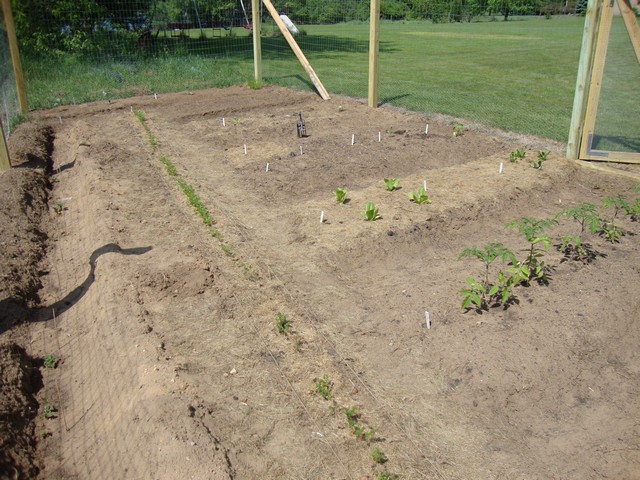
Other plants I grew this first year were: Cabbage, broccoli, cauliflower, corn, green beans, potatoes, carrots, bell and jalapeño peppers, chives, parsley, dill, basil, leeks, scallions / green onions, romaine lettuce, spinach, strawberries (in a separate section) and sun flowers. Some of these I planted again in 2011, and some I decided against, which included: corn, cabbage, broccoli (will do again in 2012), dill, leeks, and sunflowers. Instead, I added garlic, and a lot more of the plants I enjoyed the most, such as potatoes, carrots, and green beans.
Cabbage, broccoli, and cauliflower are closely related vegetables. They also will attract the same worms! Amazing where these critters come from, out of nowhere! How did they know I was planning on growing these veggies??? But they came almost as soon as the plants were in, and they invited their friends. Which wasn’t a problem as long as I kept spraying with Captain Jack’s Dead Bug Brew, which is a spray containing spinosad. This product is considered acceptable for organic gardening and works very well at keeping them away. Though I do not grow vegetables completely organic, I have so far never had to use chemical sprays other than those meant for organic gardening. As seen in my post Herbs & Flowers to Naturally Control & Deter Pests you can also read about natural pest control that I have tried.
But I regress: Broccoli was fun to do, and these plants continue to produce a lot of small florets throughout the season if spaced well apart. Cabbage went well, though since we have never been big cabbage eaters, and the rest of the family was not really in favor of increasing our use of it, I decided cabbage would leave my list. Now, my cauliflower plants: they didn’t even make it to the ground! Grown from seed, I had them in little pots inside while studying and learning, and when I found out how tricky these plants can be, and how great the frustration for the grower, I decided I didn’t want to deal with it. So they never made it past 3 inches before I decided their time was up. Very finicky plants, I learned, and if they go through any kind of stress, weather related or watering, they will bolt and decide they’re done. The flower part of it will simply stop growing even if they are no larger than a walnut. Who wants to deal with that??? I’ll buy mine at the store, and let someone else take that load.
Corn
Oh my goodness! We’ve never had a problem with raccoons before, but now all of a sudden it seemed like they had decided our yard was their new vacation place! And the thing about it is, they didn’t bother the plants at all for a while, not until the corn was almost ripe, and that’s when they made their move. Notice I said almost ripe. That part is important because it means that the raccoons helped themselves before the corn was ripe enough for us to use. And not just helped themselves nicely, noooo! It was pure vandalism! That’s when we installed electric wiring around the top of our garden fence, after first trying a few other methods, all of which had failed. But with electric wiring, they decided they’d rather raid a different garden. In a separate area I planted about 100 plants a little later, and for whatever reason, only 10% of them yielded any at all. So that was a lot of wasted work and space. In addition, these are large plants, and they do drain the soil of a lot of nutrition. All in all, I decided corn wasn’t for me. Maybe some day I will try again, but being that they are so cheap to purchase at the store, I will get them there for now.
Here you can see some of the damage from the raccoons; some plants were completely tipped over, on other plants the ears were shredded or torn off.
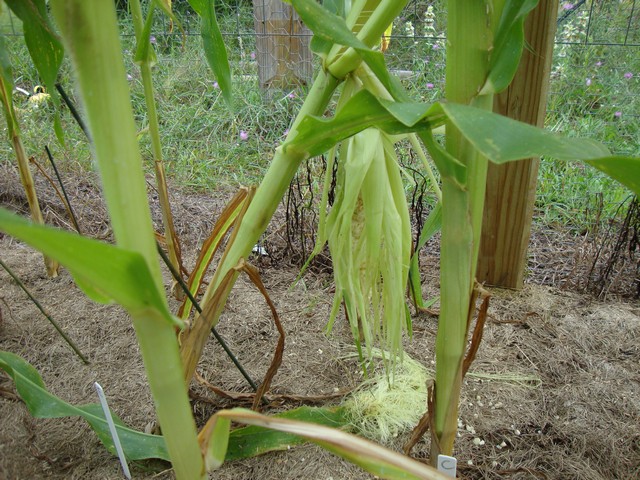
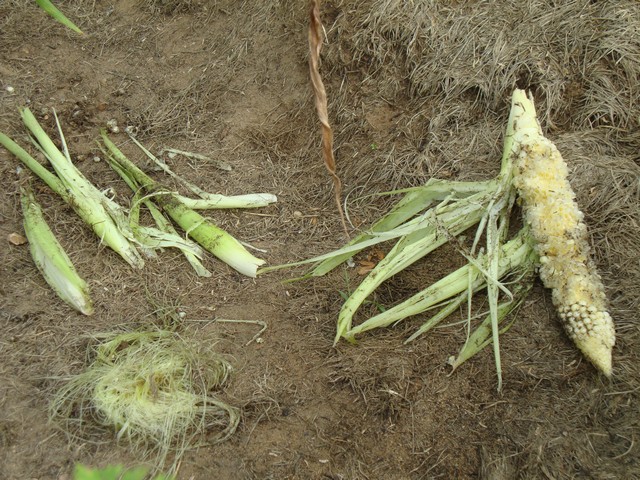
Green beans
Green beans have been an easy crop to grow and I have ended up growing them every year. I just won’t go crazy, like in 2011: After going on vacation, we came back to a forest of plants and beans! The sheer sight of it and the harvesting job I knew I had ahead of me was completely overwhelming! It was way too much and I have been more careful since then.
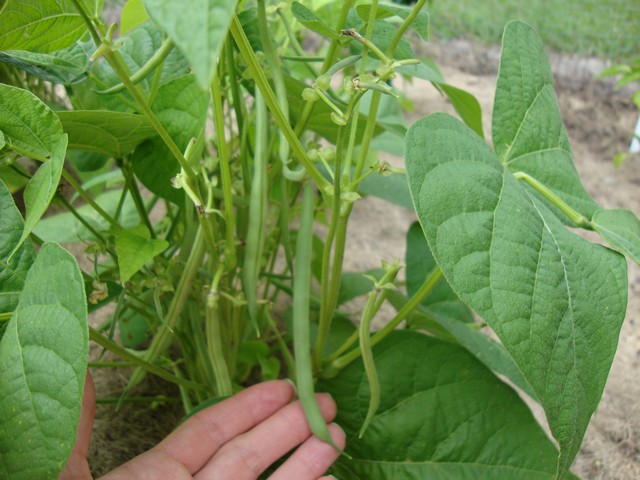
Green beans are easy and enjoyable to grow, and they yield quite well. I cut and blanch them and put them in bags in the freezer to enjoy throughout the entire winter season. They can also be planted quite tightly together, which is part of why I overdid it, but the good news is that you can cram a lot of plants into a tiny space if space is limited. They literally use each other for support and still produce a lot of beans. Here’s a post with pictures to help you along if you want to try your hand at growing green beans: Planting and Growing Green Beans in the Home Garden.
Potatoes
Potatoes were a lot of fun, and quite easy! I did get a bit riled up over how diseased these plants looked later in the season, and tried in vain to treat them with organic sprays to keep disease at bay until my dear neighbor told me that this is typical and nothing to worry about. They simply are plants that often get a myriad of diseases and that’s OK. I thought my potatoes would have all kinds of problems as well, but they were for the very most part completely fine! The following year I didn’t treat them at all, and still the potatoes themselves were of great quality. One confusing part was when they started to die off; they looked so terribly sick, like they were attacked by something devastating. But this is a natural process and simply means the potatoes will soon be ready to dig. Click this link to see pictures and learn about it; in this post are also links to my other popular picture tutorials on potatoes and how to plant, grow, and harvest them.
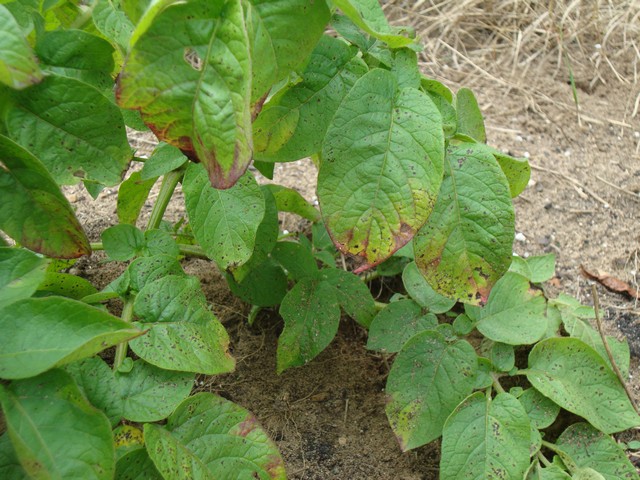
They look so nasty, don’t they? They’re starting to die off, and potatoes can be dug at this point, or stay in-ground to harden off for winter storage:
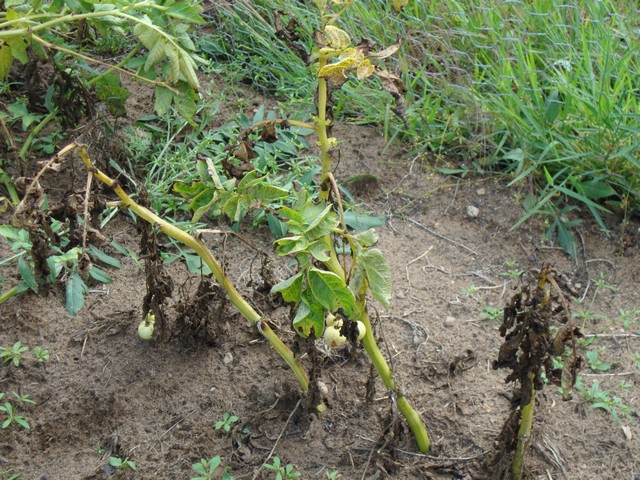
Ugly tops, but then, under ground, great things are happening!
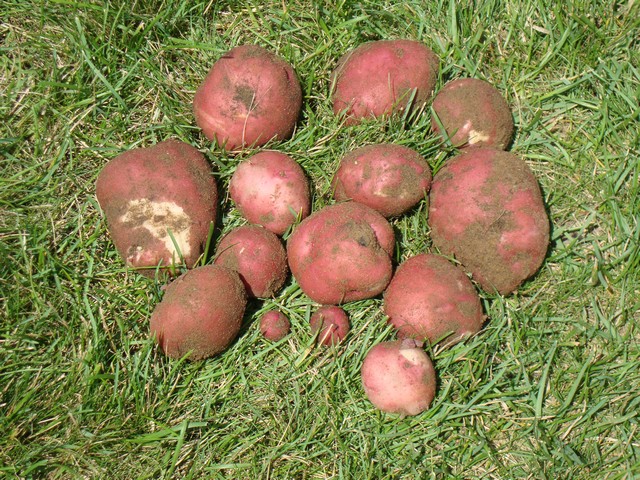
Potatoes, I found, were not too difficult to grow; they require a bit of hilling now and again (pushing soil up against the plants), and digging to harvest, but I thought it was so very rewarding to go out there and dig today’s potatoes for dinner! Another plus is that they do not need to be harvested all at once, but can be left in-ground throughout the fall or winter, depending on your climate. Mine had to be dug before winter set in, as the ground in my zone freezes.
Carrots
Carrots were fun as well, but I did learn that they should NOT be seeded inside first and transplanted later. Here’s why; just look at this funky guy, ready to go dancing:
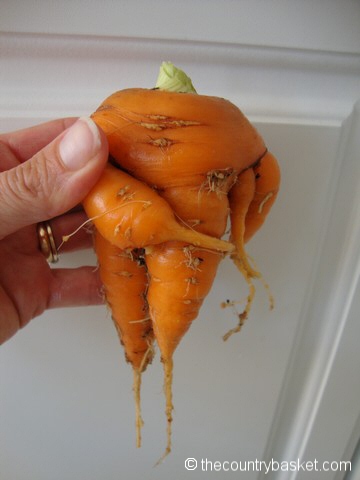
Though we did get a few laughs, we do prefer carrots that are a bit easier to brush clean. These were directly seeded outdoors:
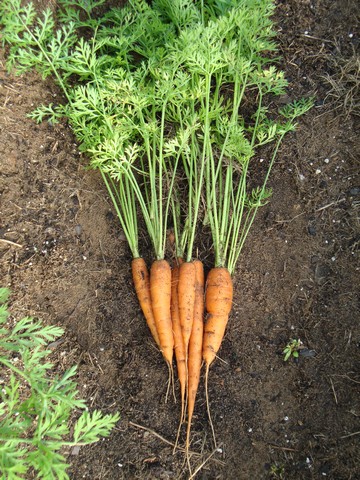
Carrots can be very tricky to get to sprout, but I have found that the most important factor in my gardening is even moisture in the first two weeks until the plants have grown just a little bit. The first year they came up right away and I had no problems. Summer of 2011, however, I tried three times in the early season, and the first two times they did not come up at all. The third time I made sure to go out several times a day to water just a tad, to keep the soil moist, and this time they did sprout. Unfortunately, just as the fragile tips started showing, we left to go on vacation and that was the end of that. Though they were watered while we were gone, it seemed they needed constant watering in the beginning, so I really had to be home to be able to do that. They also require gentleness in other areas, but I still love growing them and grow several sections every year. To learn how to successfully grow carrots, see How to Grow Carrots From Seed to Harvest. Tips & Pictures.
I will touch on the rest of the plants I planted in the following post, Vegetable Gardening -Which Plants to Choose, Part 2.
As mentioned above, the summer of 2012 I focused on how to use flowers and herbs as a way of controlling pests in the garden, finding more ways to avoid pesticides and other chemicals. It sure was an interesting experiment! Here’s a link to this post, which goes into some details of the plants I found the most fascinating, and why I will or will not continue to plant them. I hope to see you there!
I hope this post has helped you get an idea of what to do to and how to plan for a new vegetable garden, and which plants you may want to choose to get you going with planting and growing. Have fun!!
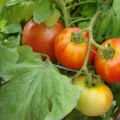
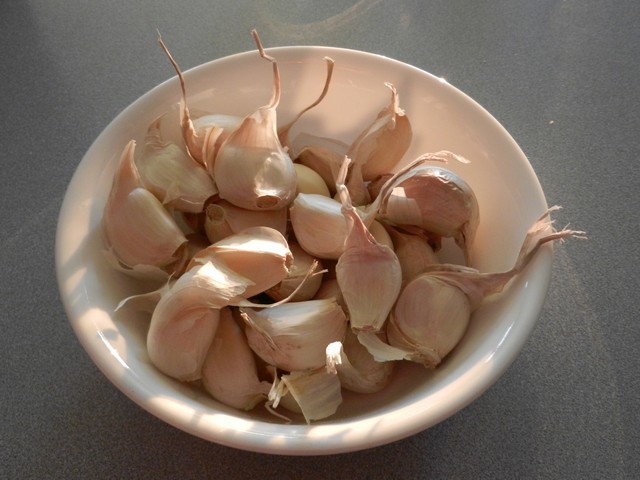
Interesting reading. Thanks for your advice (and thanks too for the plants you shared with us). About how big is your garden (how many feet by how many feet approximately)? I’d like to plant a nice garden some day and wondered what size I should start with.
Thanks!
My garden measures 29.33 ft x 19.5 ft x 29 ft x 12.5 ft, walking around it clockwise. If I did my math correctly, the perimiter is 90.33 ft., or 27.53 m, and area of 469.27 sq.ft, or 53.05 sq.m.
I don’t know what the name of the shape would be, but the two bottom corners are 90 degree angles, and one of the sides is longer than the other. So it is like a rectangle, only one of the sides is slanted, while the other three sides are straight.
To visualize a little easier, the bottom base (from where I look at it) is about 29 ft, the top is 29 ft, and the side to the right is 12 ft, the side to the left is 19 ft.
OK, my boxes aren’t showing. What did you think of the performance of the Bok Choi? And how did you cook it?
Ah, the Chinese cabbage… Didn’t care that much for it. It tastes pretty good raw, so could use it in salads. But then I cooked it in lightly salted water, and that was a big mistake. We all hated it. I won’t do those again simply because we aren’t used to eating it, and there are so many other veggies I’d rather grow.
thank you. .. there is a hope of having better future for earth 🙂